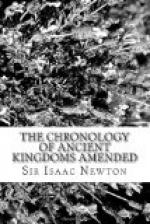Hipparchus the great Astronomer, comparing his own Observations with those of former Astronomers, concluded first of any man, that the Equinoxes had a motion backwards in respect of the fixt Stars: and his opinion was, that they went backwards one Degree in about an hundred years. He made his observations of the Equinoxes between the years of Nabonassar 586 and 618: the middle year is 602, which is 286 years after the aforesaid observation of Meton and Euctemon; and in these years the Equinox must have gone backwards four degrees, and so have been in the fourth Degree of Aries in the days of Hipparchus, and by consequence have then gone back eleven Degrees since the Argonautic Expedition; that is, in 1090 years, according to the Chronology of the ancient Greeks then in use: and this is after the rate of about 99 years, or in the next round number an hundred years to a Degree, as was then stated by Hipparchus. But it really went back a Degree in seventy and two years, and eleven Degrees in 792 years: count these 792 years backward from the year of Nabonassar, 602, the year from which we counted the 286 years, and the reckoning will place the Argonautic Expedition about 43 years after the death of Solomon. The Greeks have therefore made the Argonautic Expedition about three hundred years ancienter than the truth, and thereby given occasion to the opinion of the great Hipparchus, that the Equinox went backward after the rate of only a Degree in an hundred years.
Hesiod tells us that sixty days after the winter Solstice the Star Arcturus rose just at Sunset: and thence it follows that Hesiod flourished about an hundred years after the death of Solomon, or in the Generation or Age next after the Trojan war, as Hesiod himself declares.
From all these circumstances, grounded upon the coarse observations of the ancient Astronomers, we may reckon it certain that the Argonautic Expedition was not earlier than the Reign of Solomon: and if these Astronomical arguments be added to the former arguments taken from the mean length of the Reigns of Kings, according to the course of nature; from them all we may safely conclude that the Argonautic Expedition was after the death of Solomon, and most probably that it was about 43 years after it.
The Trojan War was one Generation later than that Expedition, as was said above, several Captains of the Greeks in that war being sons of the Argonauts: and the ancient Greeks reckoned Memnon or Amenophis, King of Egypt, to have Reigned in the times of that war, feigning him to be the son of Tithonus the elder brother of Priam, and in the end of that war to have come from Susa to the assistance of Priam. Amenophis was therefore of




